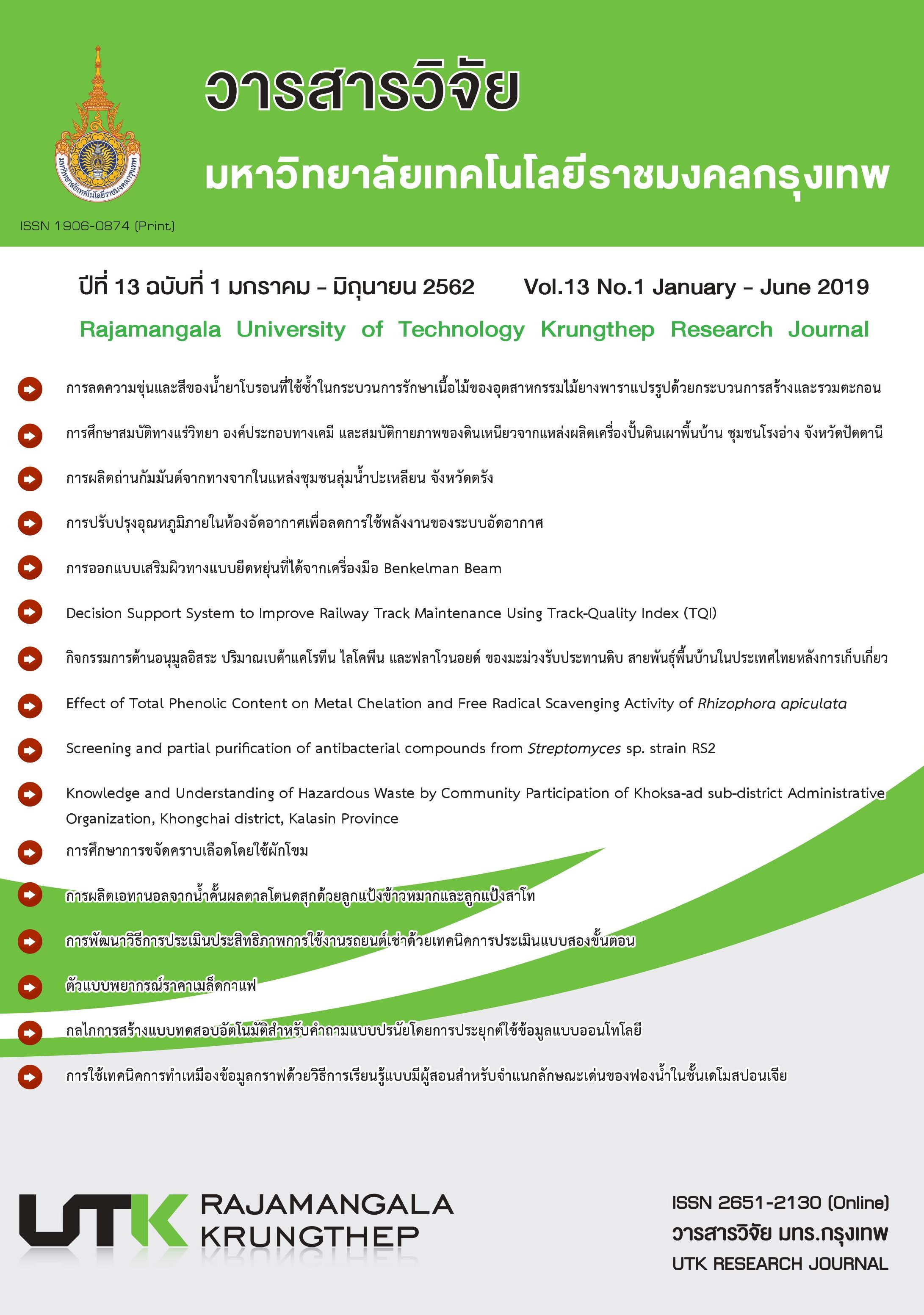Knowledge and Understanding of Hazardous Waste by Community Participation of Khoksa-ad sub-district Administrative Organization, Khongchai district, Kalasin Province
Main Article Content
บทคัดย่อ
The aims of this study were: (1) to examine the amount of heavy metals i.e. lead, mercury, copper, cadmium, manganese contaminated in soil in the area of junk shops in 12 villages of Khoksa-ad sub-district, Khongchai district, Kalasin province, and to assess the quality of groundwater and soil surface water, and measure pH and conductivity of soil and water samples. (2) to investigate hazardous waste disposal in the area of Khoksa-ad sub-district, Khongchai district, Kalasin province. The data were collected and employed the distribution of 329 copies of questionnaire the respondents.
The findings revealed that (1) the average amount of heavy substances i.e. lead and cadmium indicated the undetectable value in water quality. (2) majority of the respondents accounting for 223 people or 67.8% knew hazardous waste, 213 people or 64.7% realized the effect of hazardous waste, 246 people or 74.8% did not attend training on hazardous waste. The participation in hazardous waste management was at moderate level (x̄ = 3.29). The people expressed their suggestions on that that sub-district administrative organization should provide waste bin and collecting truck in the area. They also would like the authority to handle hazardous wastes separation and disposal appropriately.
Article Details
กองบรรณาธิการวารสารวิชาการ มหาวิทยาลัยเทคโนโลยีราชมงคลกรุงเทพ มีความยินดีที่จะรับบทความจากอาจารย์ นักวิจัย นักวิชาการทั้งภายในและภายนอกมหาวิทยาลัย ในสาขาวิชาวิทยาศาสตร์และเทคโนโลยี ได้แก่ สาขาวิชาวิทยาศาสตร์ วิศวกรรมศาสตร์ และสาขาอื่นๆ ที่เกี่ยวข้อง รวมถึงสาขาต่างๆ ที่มีการบูรณาการข้ามศาสตร์ที่เกี่ยวข้องวิทยาศาสตร์และเทคโนโลยี ที่เขียนเป็นภาษาไทยหรือภาษาอังกฤษ ซึ่งผลงานวิชาการที่ส่งมาขอตีพิมพ์ต้องไม่เคยเผยแพร่ในสิ่งพิมพ์อื่นใดมาก่อน และต้องไม่อยู่ในระหว่างการพิจารณาของวารสารอื่น
การละเมิดลิขสิทธิ์ถือเป็นความรับผิดชอบของผู้ส่งบทความโดยตรง บทความที่ได้รับการตีพิมพ์ต้องผ่านการพิจารณากลั่นกรองคุณภาพจากผู้ทรงคุณวุฒิและได้รับความเห็นชอบจากกองบรรณาธิการ
ข้อความที่ปรากฏอยู่ในแต่ละบทความที่ตีพิมพ์ในวารสารวิชาการเล่มนี้ เป็นความคิดเห็นส่วนตัวของผู้เขียนแต่ละท่าน ไม่เกี่ยวข้องกับมหาวิทยาลัยเทคโนโลยีราชมงคลกรุงเทพแต่อย่างใด ความรับผิดชอบด้านเนื้อหาและการตรวจร่างบทความแต่ละบทความเป็นของผู้เขียนแต่ละท่าน หากมีความผิดพลาดใดๆ ผู้เขียนแต่ละท่านจะต้องรับผิดชอบบทความของตนเองแต่ผู้เดียว
กองบรรณาธิการขอสงวนสิทธิ์มิให้นำเนื้อหา หรือข้อคิดเห็นใดๆ ของบทความในวารสารวิชาการ มหาวิทยาลัยเทคโนโลยีราชมงคลกรุงเทพ ไปเผยแพร่ก่อนได้รับอนุญาตจากกองบรรณาธิการ อย่างเป็นลายลักษณ์อักษร ผลงานที่ได้รับการตีพิมพ์ถือเป็นลิขสิทธิ์ของวารสาร
References
[2] Law “electronic waste” new Thais are ready? [Internet]. Bangkok: Naewna; 2014 [cited 2014 Nov 27]. Available from: http://www.naewna .com/scoop/132764
[3] Waste electronic disposal environ-mental impact [Internet]. Khonkaen: ;Khonkaen Science Centre for Education; 2013. [cited 2013 Oct 10]. Available from: http://www.kksci.com
[4] Wasnadumrongdee s, Manomaiwiboon p. Knowledgebase “Electronic waste management (E-waste)” [Internet]. Bangkok: HSM; 2015. [cited 2018 Jan]. Available from: http://www. hsm.chula.ac.th/research/paper/e-wate_management/e-wate_manage ment2.pdf
[5] The standards index according to National Environment Committee No.25 (2004) as determining soil quality standards, Government Gazette No.127(119) (2004 Oct 20).
[6] The standards index according to National Environment Committee No.8 (1994) as determine water quality standards in surface water, Government Gazette No.111(16) (February 24, 1994).
[7] Yamane T. Statistics, An Introductory Analysis, 2nd Ed., New York: Harper and Row; 1967.
[8] Natomtong K. Development model for hazardous waste management by the participation of the recycle waste buyer in Kalasin province. [Master’s thesis]. Khonkaen: Khon Kaen University; 2013.
[9] Sornsil A. Women’s role in household hazardous waste management: case study: Nongkhaem district of bangkok. [disertation]. Bangkok: Mahidol University; 2005.
[10] Jamcharean P. Electronic waste .….waste that comes with technology [Internet]. Bangkok; 2013. [cited 2014 Feb 12]. Available from: https://sites.google. com/site/krubitoey/article/khyaxilekthrxnikskhxngseiythimaphrxmkabthekhnoloyi
[11] Tangpaitoon S. Electronic waste management in Thailand. [Internet]. Bangkok; 2012. [cited 2012 Mar 29]. Available from: http://www. thailandindustry.com/indust_newweb/articles_preview.php?cid=16560

